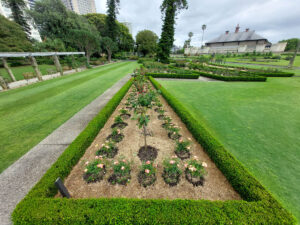
In pursuit of an organic display Rose Garden
By Tristan O’Hara
For many years, the Royal Botanic Garden Sydney (RBG) has been working towards providing a high-quality, organic, display Rose Garden under challenging circumstances.
Upfront, I am a general horticulturist, not an expert rosarian and have been entrusted with managing the RBG’s Rose Garden. During my tenure, I have developed a passion for roses and gained a wealth of experience, sitting atop the shoulders of preceding horticulturists. Their knowledge, experimentation and planning has been invaluable.
This is the ninth version of the Rose Garden in the RBG’s 216 years. Previous iterations of the Rose Garden have had many challenges typical of Sydney, including fungal diseases, pests, and inconsistent performance over the 9-month season. The public’s deep adoration and nostalgia for roses, and persistence of horticultural staff have ensured the Rose Garden remains an important part of the RBG.
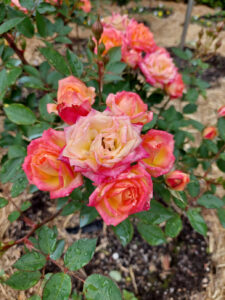
While many considerations are balanced at the RBG, including weddings, events, and education, the overarching approach informing decisions is the health of roses. Whilst that may be obvious, it is tempting to fill spaces with other plants creating a cottage style garden (roses being one element in a sea of foliage and colour). The diversity and size of the RBG means our primary focus is performance of our roses – they are the star.
With rose health at the forefront of decision making, what steps are taken to cultivate the best display across the 9-month season? Annuals and overplanting beds no longer fill space to distract from poorly performing roses. This reduces competition, humidity, potential fungal reservoirs, weeds (including violas, alyssum and other annuals), and allows for more accessible weeding. In turn, the removal of overhead irrigation and the installation of drip irrigation in beds prevents damage to rose roots on a yearly basis.
A key focus has been replacement of cultivars not suited to the environment of the RBG such as ‘Peace,’ with cultivars that thrive. This year, the removal of 150 underperforming or overplanted roses has reduced competition, and allowed air flow, sunlight and fungicide sprays to penetrate more effectively throughout the beds, providing an impressive display with healthier and productive roses.
Notably, the German breeder, Kordes have performed well. Treloar Roses’ fungal resistance testing and National Rose Trials have also assisted in guiding choices for our conditions. Roses are inoculated with mycorrhizal fungi and beneficial bacteria. A soil conditioner is applied during winter and starting in late August, a complete pelletised fertiliser (N:P:K = 9:4:12), which has an organic base and added water-soluble synthetic nutrients, is added at 3-month intervals. This is the only non-organic input that is used, including pest and weed control. Seaweed solution is applied through our fertigation system. Pop-up fertigation allows for foliar feeding, but this is not ideal for reducing fungal pathogens. To address this, we change overhead irrigation for drip lines, where possible. Strongly odorous products are not used, given events and daily visitors enjoying our urban oasis.
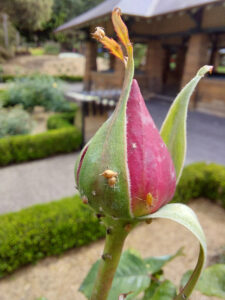
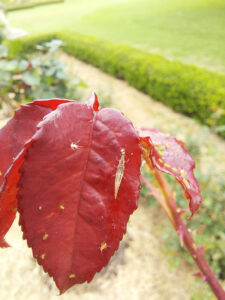
The perpetual prickle in any rose lovers’ side are fungal diseases. This year, annual rainfall has surpassed the highest amount on record. Despite this, the Rose Garden is on track for a strong and vibrant display this season. Prevention is not realistic and our program is based on significantly slowing the spread. Lime sulphur is sprayed in each bed immediately post winter pruning. Spraying during the growing season is completed in 7–14 day intervals with three organic products at different periods. This reduces potential resistance and targets different key diseases, such as black spot, botrytis blight, anthracnose, rust, powdery and downy mildew.
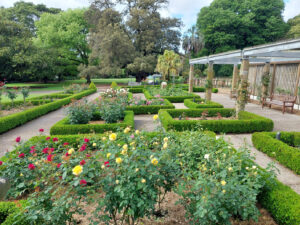
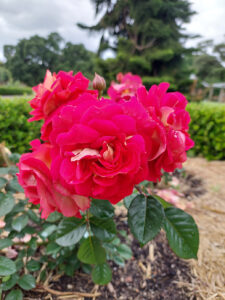
Whilst annuals no longer fill beds, strategically positioned perennials, based on their compatibility with roses and ability to provide pollen and nectar for beneficial predators, are used. Factors in choosing companion plants include long flowering periods, full sun, colour contrasts, hardiness, mass flowering, low weed potential and ‘cutting back’ for the winter rose renovation process. These perennials include Veronica spicata, Agastache rugosa and Nepeta x faassenii.
Rather than using insecticides, including horticultural oils, our beneficial predator release program promotes biodiversity to manage our key pests: aphids, scales, caterpillars, thrips, leafhoppers, mites and mealybugs. This season, eighteen beneficial predator species will be released, including ladybirds, parasitic wasps, predatory mites and nematodes. This is in addition to the multitude of naturally occurring predators established around the Rose Garden. Beneficial biodiversity is supported by dense and diverse bordering areas, including the Trial Garden and Pioneer Memorial Garden. These areas function as food sources during the growing season and for hosting beneficials after the hard winter prune, when rose beds are relatively bare. Broadly, the RBG benefits from our releases and approach as beneficials establish, reproduce and inevitably spread throughout.
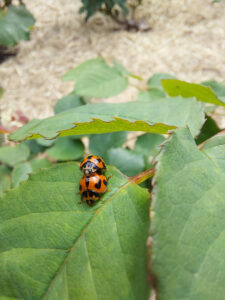
Many challenges come with growing and maintaining roses en masse in Sydney. An upcoming challenge is establishing new beds that provide an abbreviated history of roses. This project will keep rose health front and centre, and build on the pursuit of a high-quality organic display Rose Garden at the RBG.
Tristan O’Hara
Horticulturist, Rose Garden
Royal Botanic Gardens Sydney
E: tristan.ohara@botanicgardens.nsw.gov.au
